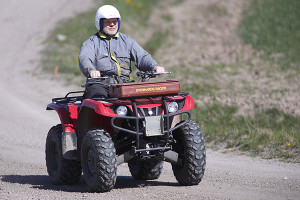According to earlier research, rollovers are a type of accident that often has severe consequences for ATV drivers. A recently published VTI study demonstrates that an active driving style is needed to drive an ATV safely, but that the requisite training is currently lacking.
Researchers at the Swedish National Road and Transport Research Institute (VTI) have conducted a study comparing the static vehicle characteristics and dynamic handling characteristics of ATVs registered as motorcycles. The results of the test drives indicate that the driver’s driving style is decisive in successfully completing certain manoeuvres. “A driver who is continuously working with their own body weight and position to counteract the forces that arise increases the likelihood of successfully completing a given manoeuvre, compared with a driver with a passive driving style”, said VTI researcher Henriette Warner Wallén.
The study was conducted in three parts, with the first two addressing the handling characteristics of ATVs. A series of static tests was performed in which the researchers used a hydraulic tilt table to measure the angle at which the vehicle rolled over laterally. A series of runs was also conducted on various test tracks to study how the ATVs behaved in different situations.
The load affects the rollover risk
Many different ATV models from different makers are on the roads. To study the differences between them, the researchers chose vehicle models from the two major categories of ATVs, i.e., sport and utility models. The results of the static tests indicate that the tendency of an ATV to roll over is strongly affected by whether or not the driver is seated on it. This is because the driver greatly affects the vehicle’s centre of gravity, as ATVs are relatively light, weighing roughly 200–400 kg.
“The tests demonstrated that an external load, in our case in the form of a 70-kilogramme crash test dummy, affects the threshold at which the vehicle will roll over. This is particularly true of the sport models, which weigh less than the utility models and are consequently affected more”, said Wallén.
The results of the dynamic tests confirm that the risk of ATV rollover can be affected by the driver. Compared with a passive style, a more active driving style increases the odds of successfully completing a given manoeuvre. The greatest risk of being forced to discontinue the test run was on a round track, which in this study measured 12–14 m in diameter. Though normal roundabouts are often larger, the speeds on normal roads exceed the 25–30 kph found here to be the top speed at which the test drivers could successfully drive on the round track.
Difficult to judge speed
The third part of the study concerned the level of knowledge of those licensed to operate ATVs. To study this, the researchers conducted focus group interviews with people who had different degrees of ATV driving experience and held different driving licenses. The focus group interviews indicated that most of the interviewees felt that an active driving style was needed to drive safely. The problem is that there is a lack of appropriate instruction in the existing driving licence training for the class B licence, which permits road operation of ATVs registered as motorcycles. The focus group interviews also indicated that it is easy to misjudge the speed at which problems may arise.
“The test runs indicate that the increase in speed, from that at which all test drivers could complete the test run to that at which all were forced to discontinue it, was relatively small. This small difference in speed indicates that the drivers have narrow safety margins in terms of potentially misjudging their speed.”
Furthermore, many participants also perceived that there was a risk that the ATV might pitch, skid, or flip. They saw that there was a risk of driving into the cones or falling off the ATV.To counteract these risks, they were aware that the driver should drive calmly and at the proper speed. The problem with driving calmly and at the proper speed lies in how the drivers are to determine just what the proper speed is, as it is obviously difficult to estimate speed correctly. Also, generally speaking, ATVs provide few warning signals before the critical point is reached and the rollover becomes a fact.
Report:
VTI report 906, Driving characteristics of quad bikes and the riders’ knowledge of these characteristics
Authors: Omar Bagdadi and Henriette Wallén Warner
Link to full report, written in Swedish
(Summary in English)
 Contact:
Contact:
Henriette Wallén Warner
henriette.wallen.warner@vti.se
VTI, Sweden







Follow us: